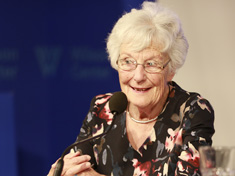-
2.6 Million Babies Are Stillborn Every Year
January 12, 2018 By Sarah B. Barnes Every day, 7,100 babies are stillborn. A tragic, complicated problem, stillbirth—which the WHO defines as a baby born with no signs of life at or after 28 weeks’ gestation—remains difficult to control and to assess. Some hospitals hide data on stillbirth, due to the shame and stigma associated with it. However, as White Ribbon Alliance CEO Betsy McCallon said at a recent Wilson Center event marking the 30th anniversary of the Safe Motherhood Initiative, stillbirth “had been hidden and neglected, but that is changing.”
Every day, 7,100 babies are stillborn. A tragic, complicated problem, stillbirth—which the WHO defines as a baby born with no signs of life at or after 28 weeks’ gestation—remains difficult to control and to assess. Some hospitals hide data on stillbirth, due to the shame and stigma associated with it. However, as White Ribbon Alliance CEO Betsy McCallon said at a recent Wilson Center event marking the 30th anniversary of the Safe Motherhood Initiative, stillbirth “had been hidden and neglected, but that is changing.”Every day, 7,100 babies are stillborn. A tragic, complicated problem, stillbirth—which the WHO defines as a baby born with no signs of life at or after 28 weeks’ gestation—remains difficult to control and to assess. Some hospitals hide data on stillbirth, due to the shame and stigma associated with it. However, as White Ribbon Alliance CEO Betsy McCallon said at a recent Wilson Center event marking the 30th anniversary of the Safe Motherhood Initiative, stillbirth “had been hidden and neglected, but that is changing.”
Distinguishing a stillbirth from a neonatal death can be challenging, particularly when the lack of a skilled birth attendant prevented adequate resuscitation. Despite the complexity, “we need to measure it,” said Barbara Kwast, one of the pioneers of the Safe Motherhood Initiative.
While stillbirth was not included in the original SDGs, after strong advocacy by the international global health community and bereaved families, stillbirth is now part of the SDG’s Every Woman Every Child framework. UNFPA’s Petra ten Hoope-Bender cited a new “people’s movement” that is bringing “dynamism, new energy into that agenda.”
To reduce the rate of stillbirths, Kwast urged the maternal health community to decrease the rate of birth asphyxia and to use a partograph to help make decisions during labor. “The international community has done an extraordinary amount of work around third stage [of labor] to prevent postpartum hemorrhage,” but now “we need to pay more attention to the first and second stages of labor,” where 50 percent of stillbirths occur.
This audio was recorded at an event at the Wilson Center on December 8, 2017.
Sources: Every Woman Every Child, March of Dimes, Mayo Clinic, Midwifery, Research Gate, United Nations, UCSF Benioff Children’s Hospital, White Ribbon Alliance, World Health Organization (WHO)
Friday Podcasts are also available for download on iTunes and Google Podcasts.
 A Publication of the Stimson Center.
A Publication of the Stimson Center.

 Every day, 7,100 babies are stillborn. A tragic, complicated problem,
Every day, 7,100 babies are stillborn. A tragic, complicated problem, 

